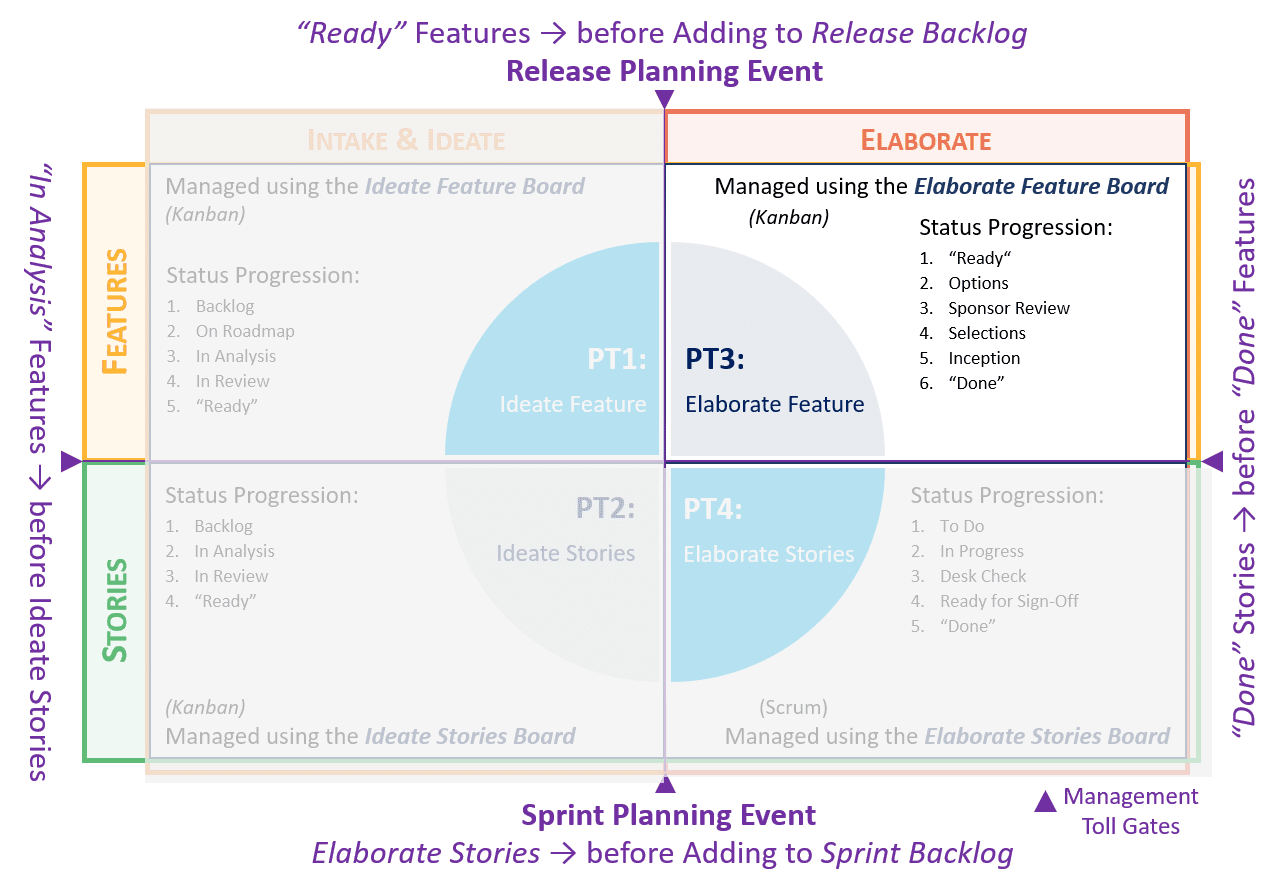This part of Portfolio Management (PPM) describes the third of four (3 of 4) Portfolio Tasks to manage Requests for Change related to the Iterative Transformation Model. By making it through PT1: Ideate Feature (Request) and PT2: Ideate Stories, the Request is feasible. Further, it has sufficient value, and priority, to justify expending additional resources upon it. Sooner or later, those resources will define a future-state Solution, Epic, or Capability, as appropriate within the organization's overall technology portfolio.
In general, this task manages that definition. Additionally, it also facilitates transition of work on to a Solution Delivery group. Afterwards, Solution Management, rather than Portfolio Management, becomes responsible for achieving the original Customer Request.
After reviewing the content of this page, check out the additional information on the following topics.
Setting Up for Success: Steps to Initiate a Suitable Solution
The Elaborate Feature Board manages several, related activities. To illustrate, the table below depicts the columns of the board. The board conveys the following aspects:
Elaborate Feature Board
| "Ready" | Options | Sponsor Review | Selections | Inception | "Done" |
|---|---|---|---|---|---|
| Feature (Request) has completed Ideate. Additionally, it has approval to progress on to Elaborate. | Feature (Request) selected into a Portfolio Release cycle. | Options, high-level estimates, as well as Solution Vision & Epics to be reviewed and approved. | Progress towards Solution(s) is approved. Initial Request may result in one or more Solutions, Epics and/or Capabilites. Each Solution to be listed here independently. | For each Solution, selected App / Tech / Tool / Vendor / Partner (as appropriate for the Solution) begin work with Solution Delivery members during Solution Inception. | Inception is complete. Solution transition from TMO ownership to PMO and/or Solution Delivery ownership is complete. New owners responsible for Solution Delivery. |
| Feature (Request) will remain in this state until selection for Elaboration during a Release Planning Event. | While here, identify Solution options. Also, prepare time & cost estimates to 50% accuracy. Finally, draft PL1 artifacts. | While here, awaiting decision on whether or not to proceed. Additionally, Capacity Planning also underway. | While here, make App / Tech / Tool / Vendor / Partner selections for each Solution. Afterwards, prepare initial versions of Solution Strategy & Architecture materials. | While here, define Business Processes to L3 (if appropriate), define PL1 artifacts; produce initial PL2 artifacts; establish WMS; create initial Solution Backlog; budgets & estimates to 85% accuracy; finalize Business Case. | Remove Feature (Request) from this board at the conclusion of the initial round of Solution Release Planning. |
| Step 1 | Step 2 | Step 3 | Step 4 | Step 5 | Step 6 |
1. Manage Progress of Multiple Requests
- Selecting a Feature for Elaboration occurs during a Release Planning Event. Selecting a Feature adds it to the Release Backlog.
- Once in the Release Backlog, priority is given to completing a Feature's Elaborate steps, over work on other Requests not yet selected in a Release. That is, complete planned changes to the technology portfolio already underway, rather than starting new ones.
- Additionally, the board depicts the priority of Features in the current Release Backlog, relative to one another. In effect, a Feature's progress, towards the right, offers the first order of relative priority. The second order is its rank within any column, towards the top. Together, these indicate which Features, as well as their related Elaborate Stories, have priority. In other words, work changes to the technology portfolio that are furthest along.
2. Define the Solution(s)
- Completion of each Request occurs through Elaborate Feature Steps 1 – 6. Each step represents a hand-off in ownership, or accountability, for completing the work expected for each step along the way.
- Each step adds a set of Elaborate Stories to the Release Backlog. These Stories represent the artifacts that define the Solution, and which guide subsequent delivery. Once all Stories for each step are complete, the Feature (Request) itself progresses on to the next step.
3. Establish Guidance and Guardrails
- By the end of this task, Feature (Request) will transition to one or more corresponding Solution(s). From that point on, Solution Management will take responsibility to implement the Solution(s), Epic(s), and/or Capability(ies) through which the requested change can be delivered. Each Solution contributes its own portion of the overall change to the technology portfolio.
- Additionally, many of the materials produced during these steps will define the Solution's scope over the next Phase. Further, they will also prescribe work which should, and should not, be done during subsequent Solution Delivery.
Portfolio Task Boards
Portfolio Task 3 of 4 - Elaborate Feature manages these steps. It governs the actions in the upper-right quadrant of the 4 Portfolio Task Boards as depicted.
Step-by-step, the definition of the potential change to the overall technology portfolio comes into greater focus. Further, at each step, there are checks to ensure that the Feature's continued progress is desirable. Each step moves the Feature (Request) through Solution Definition, and closer to its transition on to Solution Delivery.
To conclude, the steps (or Statuses) represent the actions which Elaborate the Feature (Request). In other words, to move the Request towards the Solution(s), Epic(s) and/or Capability(ies) that will deliver the requested change. In effect, they define what happens to a Feature after selection during a Release Planning Event.
The pages above describe each step of the task in detail.

After reviewing the pages above, look to the corresponding task PT4: Elaborate Stories. That task manages the development of each artifact used to define each incremental change to the technology portfolio.
